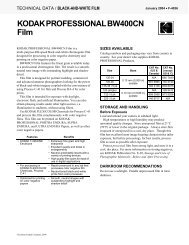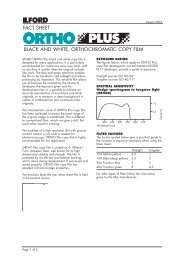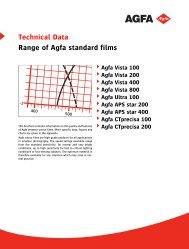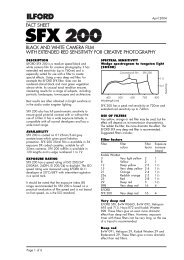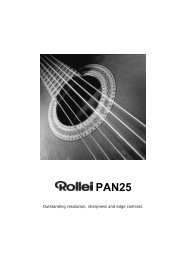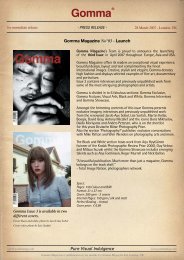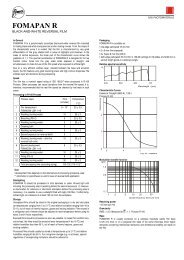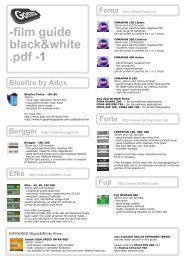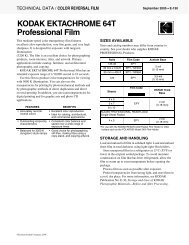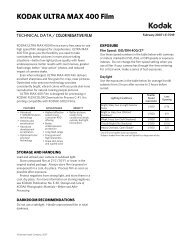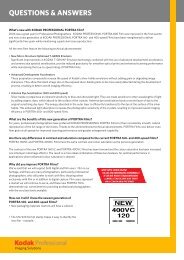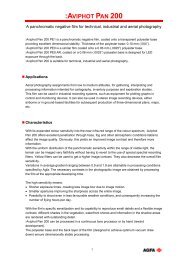Avitone p1p-p3p - Gomma
Avitone p1p-p3p - Gomma
Avitone p1p-p3p - Gomma
You also want an ePaper? Increase the reach of your titles
YUMPU automatically turns print PDFs into web optimized ePapers that Google loves.
:AVITONE P1 P AND P 3 P<br />
Negative acting, orthochromatic continuous tone duplicating film.<br />
:<strong>Avitone</strong> P 1 p and P 3 p are negative acting, orthochromatic continuous tone duplicating films for<br />
black-and-white originals.<br />
Thickness of the polyester base:<br />
P 1 p: 0.10 mm (.004”).<br />
P 3 p: 0.18 mm (.007”).<br />
• Applications<br />
The films are suitable for duplication of continuous tone negatives, such as aerial or other<br />
photographic originals, either in contact (with or without electronic contrast compensation) or by<br />
projection when enlarging images.<br />
The films can also be used for film duplication in cartographic and military applications.<br />
• Features<br />
• Very high resolution: clear cut line definition and therefore excellent detail rendering.<br />
• The fine grain emulsion enhances detail rendering. Reproduction can make the weak contrast in<br />
some originals stronger until it reaches an optimum level. The fine grain structure is maintained<br />
even with extended development.<br />
• The image contrast and gradient of :<strong>Avitone</strong> P 1 p and P 3 p can be controlled by adjusting the<br />
developing time. You will obtain good results by over-developing underexposed films and underdeveloping<br />
overexposed images.<br />
• The density range can differ with every original. By adjusting the developing time the copy will<br />
reach a density suitable for optical projections.<br />
• Dimensionally stable duplicates can be made under strictly controlled processing conditions, i.e.<br />
an homogeneous pressure/vacuum on the contact frame, a drying temperature of maximum<br />
45 °C/113 °F and a relative humidity between 30% and 60%.<br />
• The back layer contains anti-halation dyes to ensure image definition.<br />
• The film is anti-static, before and after processing.<br />
• :<strong>Avitone</strong> P 1 p and P 3 p can be processed in various continuous tone developers, in machine or<br />
in tray.<br />
1
• Photographic data<br />
Spectral sensitivity<br />
RMS Granularity<br />
2
Modulation Transfer Function (MTF)<br />
Resolution<br />
TOC (Target Object Contrast) measured according to ANSI PH 22.23-1980.<br />
TOC 1000:1 = 256 lp/mm or 512 dots/mm.<br />
TO 1.6:1 = 161 lp/mm or 322 dots/mm.<br />
3
• Production Guidelines<br />
Darkroom lighting<br />
Red light, e.g. an R6-filter over a 25W lamp at 1.25 m minimum distance from the film.<br />
Exposure example<br />
Klimsch contact frame with halogen point light, light intensity 13 lux.<br />
Exposure time 8 s, Dmin original 0.3, Dmax original 1.3.<br />
Exposure time 16 s, Dmin original 0.6, Dmax original 1.6.<br />
Processing<br />
:<strong>Avitone</strong> P 1 p and P 3 p can be processed in machine or in tray.<br />
Automatic processing in :Gevatone 66, in G 74 c developer.<br />
The developing time can be varied between 20 and 70 seconds, depending on the required<br />
gradation.<br />
Developing temperature: 30°C/86°F.<br />
The recommended replenishment rate is 300 ml/m2 for the developer and 500 ml/m2 for the fixer<br />
(G 333 c).<br />
• Characteristic curves<br />
Developing temperature: 25 °C<br />
4
Developing temperature: 30 °C<br />
Developing temperature: 35 °C<br />
5
• Exposure/time curve<br />
• Average gradient<br />
6
• Fog/time curve<br />
Automatic processing in :AgfaLine, in G 101 c developer<br />
The developing time can be varied between 20 and 25 s, depending on the required gradation.<br />
Developing temperature: 35 °C/95 °F to 38 °C/100 °F.<br />
The recommended replenishment rate is 250 ml/m2 for the developer and 500 ml/m2 for the fixer<br />
(G 333 c).<br />
• Characteristic curves<br />
Developing temperature of 35 °C and 38 °C<br />
7
• Exposure/time curve<br />
• Average gradient/time curve<br />
• Fogt/time curve<br />
8
Processing in tray<br />
Developer: G 74 c at 20 °C/68 °F, for 1 to 5 minutes.<br />
Fixer G 333 c at 20 °C/68 °F, for 30 s.<br />
Wash thoroughly, preferably in running water.<br />
• Characteristic curves<br />
• Exposure/time curve<br />
9
• Average gradient/time curve<br />
• Fog/time curve<br />
10
Storage<br />
:<strong>Avitone</strong> P 1 p and P 3 p films have to be kept in a dry and cool place, preferably at a temperature<br />
between 2 °C/36 °F and 10 °C/50 °F. The film should be taken out of the cool room at least 30<br />
minutes before use.<br />
Keeping the film in deep freeze (at –10 °C/+14 °F) considerably delays the ageing process and<br />
guarantees a longer life. Film which has been kept in deep freeze has to remain in room<br />
temperature for at least 8 hours before use.<br />
• Assortment<br />
:<strong>Avitone</strong> P 1 p<br />
Size Spool/Winding/Perforation Order code<br />
126 mm x 213,5 m 5 in x 700 ft AN397 – EI – NP 3FDW7<br />
240 mm x 76 m 9 7/16 in x 249 ft AH897 – EI – NP 3HCAB<br />
240 mm x 152 m 9 7/16 in x 500 ft AM897 – EI - NP 3FDV5<br />
:<strong>Avitone</strong> P 3 p<br />
Size Spool/Winding/Perforation Order code<br />
24 x 24 cm 9 7/16 x 9 7/16 in 100 sheets 3E7OV<br />
24 x 26.2 cm 9 7/16 x 10 5/16 in 100 sheets 3E7QZ<br />
25.4 x 25.4 cm 10 x 10 in 100 sheets 3E7T6<br />
Subject to changes without prior notice.<br />
AGFA, the Agfa-Rhombus, <strong>Avitone</strong>, Gevatone and Rapiline are trademarks of Agfa-Gevaert AG, Germany and<br />
Agfa-Gevaert N.V., Belgium.<br />
©2004 Agfa-Gevaert N.V., B 2640 Mortsel - Belgium<br />
March 2004<br />
11




